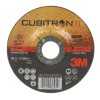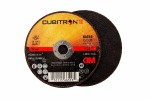What grit level should abrasive disc have?
What grit level should abrasive discs have? When it comes to buying a new set of abrasive discs for your own angle grinder, or possibly for a sander, it is not uncommon to wonder about which grit level to choose.
To make an effective choice it is, therefore, necessary to examine the surfaces that you will have to work on, as well as the specific processing that you will need to carry out, thus being aware of the degree of aggression that the perfect abrasive disc you’re going to use must have.
High-pressure machining, such as heavy deburring, requires a certain type of grain, while low-pressure machining, such as aesthetic finishing, requires a grain of a completely different type, instead.
Using an abrasive disc with too high a grit can lead to excessive removal of material, as well as the creation of lines and grooves; using an abrasive disc with too thin a grit, on the other hand, can render the whole operation completely ineffective.
It is, therefore, paramount to find the perfect compromise each time: in this article we will outline what grit level the ideal abrasive disc should have, after describing the main types of abrasive themselves.
The main types of abrasives
What are the main types of abrasives, when considering abrasive discs? Let’s begin from the very definition of abrasive: this term refers to a hard material that, when chopped into many small pieces, is placed and fixed on a rigid or semi-rigid surface.
With an abrasive obtained thusly, it is possible to remove some paint before repainting a piece of furniture, sand wood after the process of planing or cutting, finish a weld, remove rust, and so on. With an abrasive it is, then, possible to smooth, debur, strip, rough, and so on.
With this wide range of possible operations in mind, even on different materials, it is clear how important it is to choose the correct abrasive disc each time.
That said, it is useful to keep in mind that there are abrasives on the market with both natural and synthetic granules. These two categories are identified according to the origin of the granules used for the realization of the disc itself.
Among natural granule abrasives are, for instance, all supports with flint (such as typical sandpaper) or corundum; among synthetic granules abrasives are zirconium oxide granules, or silicon carbide.
What grit level should abrasive discs have?
Having discussed the nature of the granules, let’s have a look at what level of grit abrasive discs must have. Two factors determine it, namely the size and number of granules on the abrasive disc.
The larger the size of the granules, and the smaller their number, the more aggressive, stronger, and less delicate the abrasive disc. The smaller the size of the granules, and the greater their number, the more delicate, less powerful the abrasive disc will be, therefore more suitable for finishing.
Each producer indicates the different grit level with different denominations: consumers only need to keep in mind that, the higher the grain number, the finer the abrasive disc. As this number increases, the aggressiveness of the abrasive disc decreases, thus so does the abrasive power of the support itself.
Very large abrasive supports are considered to be less than 50 grit, coarse or medium grit between 50 and 80, and medium or fine grit between 80 and 100, and decidedly fine grit from 100 onwards. Abrasive supports with a very high level of grit are suitable for painting and fine sanding.
What grit level should abrasive discs have? A few examples
Among the best abrasive discs on the market there are certainly 3M’s Cubitron fibrate discs, or discs with a triangular shape ceramic abrasive.
The granulate, in this case, has been designed and created to be consume in a regular way, and to continue to sharpen from use.
3M’s Cubitron fibrate abrasive discs are available with different grit levels, from 36 to 80 grit, through 60 grit. These are abrasive discs perfect for finishing, for grinding welds, and for bevelling edges; for powerful degreasing, however, very large 36 grit is preferred, whereas for a smoother finish it is best to opt for an abrasive disc grit level of 80.







